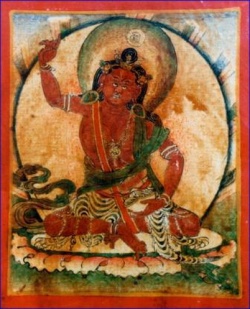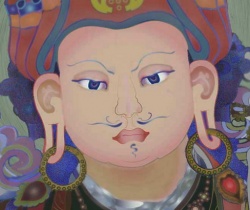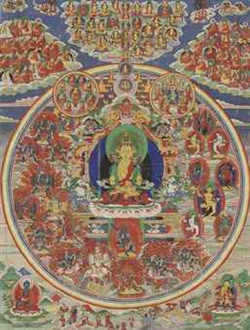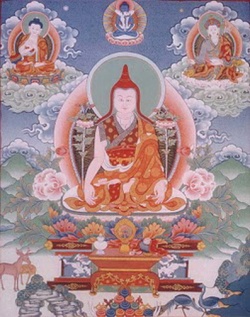The Tree of Enlightenment: An Introduction to the Major Traditions of Buddhism - Chapter Three: The Life of the Buddha
The Tree of Enlightenment
An Introduction to the Major Traditions of Buddhism
Peter Della Santina
Chapter Three
The Life of the Buddha
Next I would like to turn to the life of the Buddha Shakyamuni. I shall not attempt to treat this topic exhaustively, nor to cover the great majority of the biography of Shakyamuni. The accounts of the life of the Buddha are for the most part narrative, and they have been presented elsewhere by both ancient and modern authors. Instead, I would like to use this brief consideration of the life of the Buddha to draw attention to a few important Buddhist values that are strikingly illustrated in the accounts of the life of Shakyamuni.
In Chapter 2, I discussed the origins and nature of the two ancient traditions of India, the one having its source in the religious culture of the Indus Valley civilization and the other associated with the Aryan civilization. In addition, I indicated that these two ancient traditions, originally quite different, in the course of time began to interact with and influence each other until, by the first millennium of the common era, they became almost indistinguishable one from the other. It is, perhaps, no coincidence that the area of the north central Gangetic plain and the Nepalese Tarai, which came to be known as "the central country," or Madhyadesha, was one of the regions in which the two traditions came into active contact, and even conflict. The priests who were custodians of the Aryan tradition associated the eastward movement of Aryan civilization with the threat of a dissipation of the purity of Aryan culture and with the growth of unorthodox practices and attitudes.
The history of religions teaches that, when two very different traditions like those of the Indus Valley civilization and the Aryans come into contact and conflict, a tremendous potential is created for the growth of new attitudes and patterns of religious culture. The life and teaching of the Buddha can be usefully viewed in the context of this historical phenomenon. Moreover, as mentioned in Chapter 2, there were significant social, economic, and political changes affecting the lives of the people of the region in the sixth century B.C.E. These naturally contributed to a heightened level of religious consciousness. It has consistently been the case that, in times of major social, economic, and political change, people tend to look inward for safety and security in an ever more uncertain world. They instinctively look to religion--and to the ostensibly unchanging values embodied in religious belief and practice--for stability in the midst of uncertainty. Such periods have almost always produced great religious revolutions and revivals. This was most certainly the case in sixth century India, just as it was in China in the sixth century, and just as it was at the beginning of the Christian era in the Mediterranean world.
There are three values of paramount importance that emerge from the life of the Buddha: (1) renunciation, (2) love and compassion, and (3) wisdom. These values stand out very clearly in many episodes throughout his life. It is no coincidence that these three, taken together, are the essential requisites for the attainment of nirvana, or enlightenment. According to the teaching of Buddhism, there are three afflictions which cause us to be reborn again and again in the wilderness of cyclical existence--namely, attachment, aversion, and ignorance. These afflictions are eliminated by the correctives of renunciation, love and compassion, and wisdom, respectively. Through cultivating these three attitudes, the Buddhist practitioner is able to remove the afflictions and attain enlightenment. Consequently, it is no accident that these attitudes should feature so prominently in the life of the Buddha Shakyamuni.
Let us consider these essential attitudes one by one, beginning with renunciation. As in the case of love and compassion, the first signs of renunciation manifested themselves very early in the life of the Buddha. Basically, renunciation is the recognition that all existence is permeated by suffering. When you realize this, it leads to what we might call a turning about, that is to say, the realization that all of common life is permeated by suffering causes us to look for something more or something different. This is precisely why suffering is counted as the first of the Four Noble Truths, and why the clear recognition of the reality and universality of suffering is the essence of renunciation.
Now, as it happens, Prince Siddhartha is believed to have participated, as we might expect, in the annual plowing ceremony of his clan at the tender age of seven. It was then that, while watching the proceedings, the young prince noticed a worm that had been unearthed being devoured by a bird. This casual observation led Siddhartha to contemplate the realities of life--to recognize the inescapable fact that all living beings kill one another to survive, and that this is a great source of suffering. Already, at this early age, we find in the Buddha's biography the beginning of the recognition that life as we know it is permeated by suffering.
If we look again at the biographical accounts of Siddhartha's early life, we soon come to the famous episode of the four sights that moved him to renounce the life of a householder and adopt the life of an ascetic in order to seek the truth. Seeing an old man, a sick man, and a corpse led him to consider why it was that he should feel unsettled by these sights. Clearly, he himself was not immune to these conditions but was subject to the inevitable succession of old age, sickness, and death. This recognition led the prince to develop a sense of detachment from the ephemeral pleasures of this world and prompted him to seek the ultimate truth about existence by way of renunciation.
It is important to remember at this stage that the prince's renunciation was not prompted by despair occurring in the ordinary course of life. He enjoyed the greatest possible happiness and privilege known in his day, and yet he recognized the suffering inherent in sentient existence and realized that, no matter how much we may indulge ourselves in pleasures of the senses, eventually we must face the realities of old age, sickness, and death. Understanding this--and encouraged by the fourth sight, that of an ascetic--Siddhartha was moved to renounce the life of a householder and to seek ultimate truth for the benefit of all living beings.
Let us look next at the attitude of love and compassion, which also appears very early in the life of the Buddha. The most striking example is the episode of the wounded swan. The biographical accounts tell us that the prince and his cousin Devadatta were wandering in the park that surrounded the royal residence when Devadatta shot down a swan with his bow and arrow. Both youths ran toward where the swan had fallen, but Siddhartha, being the faster runner, reached the place first. The young prince gathered the wounded bird up in his arms and sought to allay its suffering. Devadatta reacted angrily to this, insisting that the swan belonged to him, inasmuch as he had shot it down. The youths took their dispute to the wise man of the court, who decided to award the bird to Siddhartha on the grounds that life rightly belongs to him who would preserve it and not to him who would destroy it.
In this simple story, we have an excellent example of the Buddha's early manifestation of the attitude of love and compassion, an attitude whose object is to foster as far as possible the happiness of others and to allay their suffering. Later, also, after his enlightenment, the Buddha continued to demonstrate this attitude in remarkable ways. There is, for instance, the well-known episode wherein the Buddha took it upon himself to nurse the ailing monk Tissa. The latter's illness was such as caused all the other members of the Order to shun him. However, the Buddha, resolved to lead by example, personally cleaned and cared for Tissa's diseased and decaying body, thereby alleviating his suffering.
Last, let us take a long look at the attitude of wisdom, which is the most important of the three, being commensurate with enlightenment itself. It is wisdom that finally opens the door to freedom, and wisdom that removes ignorance, the fundamental cause of suffering. It is said that while one may sever the branches of a tree and even cut down its trunk, if the root is not removed, the tree will grow again. In a similar way, although one may remove attachment by means of renunciation, and aversion by means of love and compassion, as long as ignorance is not removed by means of wisdom, attachment and aversion are liable to arise again.
The principal instrument through which wisdom may be gained is meditation. Again, there is an event early in the Buddha's life in which his precocious skill in concentrating the mind is evident. According to the accounts of the life of Shakyamuni, immediately after witnessing the unhappy incident involving the worm and the bird at the plowing ceremony, the prince sat under a nearby rose-apple tree, and there spontaneously began to meditate, achieving the first level of meditation by concentrating his mind on the process of inhalation and exhalation. In this event we have evidence of a very early experience of meditation in the life of the Buddha.
Later, when he renounced the life of a householder and went forth to seek the ultimate truth, one of the first disciplines he developed was that of meditation. The accounts tell us that the ascetic Gotama (as he was known during his six years of striving for enlightenment) studied under two renowned teachers of meditation, Alara Kalama and Uddaka Ramaputta. Under the tutelage of these teachers he studied and mastered the various techniques of concentrating the mind. In Chapter 2 I mentioned that there is evidence which suggests that the origins of meditation go back to the dawn of Indian civilization, to the golden age of the Indus Valley civilization. It is very likely that the two teachers mentioned in the biographies of the Buddha were exponents of this very ancient tradition of meditation, or mental concentration.
And yet, remarkably, the ascetic Gotama left the two teachers in question because he found that meditation alone could not permanently put an end to suffering, even though it might supply temporary relief. This fact is important, because although the teaching of the Buddha emphasizes the practice of mental development and is therefore clearly in the tradition of the Indus Valley civilization, the Buddha transcended the limited goals of mere meditation and brought a new dimension to religious experience. This is what distinguishes the Buddha's teaching from the teaching of many other Indian schools, particularly those which, in one form or another, embrace the practice of yoga, or meditation.
In short, what distinguishes Buddhism from the contemplative traditions of Hinduism and other religions is the fact that, for Buddhism, meditation by itself is not enough. We might say that, for Buddhism, meditation is like sharpening a pencil. We sharpen a pencil for a purpose, let us say, in order to write. Similarly, by means of meditation we sharpen the mind for a definite purpose--in this case, the purpose is wisdom. The relationship between meditation and wisdom has also been explained with the help of the example of a torch. Suppose we want to see a picture on the wall of a darkened room with the aid of a torch. If the light cast by the torch is too dim, if the flame is disturbed by drafts of air, or if the hand holding the torch is unsteady, it is impossible to see the picture clearly. Similarly, if we want to penetrate the darkness of ignorance and see into the real nature of existence, we will be unable to do so if our minds are weak, distracted, and unsteady as a consequence of habitual indolence and emotional and intellectual disturbances. The Buddha put this discovery into practice on the night of his enlightenment. Then, we are told, he made his mind concentrated, one-pointed, and supple by means of meditation, directed it to the understanding of the real nature of things, and comprehended the truth. Therefore, the enlightenment of the Buddha was the consequence of the combination of meditation and wisdom.
There are also other dimensions of wisdom exemplified in the life of the Buddha. One of these is the understanding of the Middle Way. The conception of the Middle Way is central in Buddhism and has many levels of meaning, all of which it is not possible to consider here. However, this much may be said at once: The most fundamental meaning of the Middle Way is the avoidance of the extremes of indulgence in pleasures of the senses and, alternatively, tormenting the body. This fundamental aspect of the Middle Way is illustrated in the life of the Buddha by his very own career and experience. Before his renunciation of the life of a householder, Siddhartha enjoyed a life of luxury and sensual pleasure. Later, when he had become an ascetic in search of the truth, he spent six years practicing all manner of physical deprivations and self-mortification. Eventually, he understood the futility of such practices as well as the meaninglessness of his former life of indulgence, and discovered the Middle Way that avoids both extremes.
There are, of course, many other important episodes in the life of the Buddha that would be interesting and valuable to discuss, but my point in choosing to concentrate on these few elements is simply that we can begin to look at the Buddha's life as a lesson in conduct and concept, and not simply as a biography containing a number of names and places. Then we can appreciate the attitudes exemplified in Shakyamuni's career. In this way, a greater and more genuine insight into the real significance of the life of the Buddha becomes possible.
Continue Reading
Part One: The Fundamentals of Buddhism
- The Tree of Enlightenment: An Introduction to the Major Traditions of Buddhism - Chapter One: Buddhism: A Modern Perspective
- The Tree of Enlightenment: An Introduction to the Major Traditions of Buddhism - Chapter Two: The Pre-Buddhist Background
- The Tree of Enlightenment: An Introduction to the Major Traditions of Buddhism - Chapter Three: The Life of the Buddha
- The Tree of Enlightenment: An Introduction to the Major Traditions of Buddhism - Chapter Four: The Four Noble Truths
- The Tree of Enlightenment: An Introduction to the Major Traditions of Buddhism - Chapter Five: Morality
- The Tree of Enlightenment: An Introduction to the Major Traditions of Buddhism - Chapter Six: Mental Development
- The Tree of Enlightenment: An Introduction to the Major Traditions of Buddhism - Chapter Seven: Wisdom
- The Tree of Enlightenment: An Introduction to the Major Traditions of Buddhism - Chapter Eight: Karma
- The Tree of Enlightenment: An Introduction to the Major Traditions of Buddhism - Chapter Nine: Rebirth
- The Tree of Enlightenment: An Introduction to the Major Traditions of Buddhism - Chapter Ten: Interdependent Origination
- The Tree of Enlightenment: An Introduction to the Major Traditions of Buddhism - Chapter Eleven: The Three Universal Characteristics
- The Tree of Enlightenment: An Introduction to the Major Traditions of Buddhism - Chapter Twelve: The Five Aggregates
- The Tree of Enlightenment: An Introduction to the Major Traditions of Buddhism - Chapter Thirteen: The Fundamentals in Practice
Part Two: The Mahayana
- The Tree of Enlightenment: An Introduction to the Major Traditions of Buddhism - Chapter Fourteen: The Origins of the Mahayana Tradition
- The Tree of Enlightenment: An Introduction to the Major Traditions of Buddhism - Chapter Fifteen: The Lotus Sutra
- The Tree of Enlightenment: An Introduction to the Major Traditions of Buddhism - Chapter Sixteen: The Heart Sutra
- The Tree of Enlightenment: An Introduction to the Major Traditions of Buddhism - Chapter Seventeen: The Lankavatara Sutra
- The Tree of Enlightenment: An Introduction to the Major Traditions of Buddhism - Chapter Eighteen: The Philosophy of the Middle Way
- The Tree of Enlightenment: An Introduction to the Major Traditions of Buddhism - Chapter Nineteen: The Philosophy of Mind Only
- The Tree of Enlightenment: An Introduction to the Major Traditions of Buddhism - Chapter Twenty: The Development of Mahayana Philosophy
- The Tree of Enlightenment: An Introduction to the Major Traditions of Buddhism - Chapter Twenty-One: Mahayana Buddhism in Practice
- The Tree of Enlightenment: An Introduction to the Major Traditions of Buddhism - Chapter Twenty-Two: The Origins of the Vajrayana Tradition
Part Three: The Vajrayana
- The Tree of Enlightenment: An Introduction to the Major Traditions of Buddhism - Chapter Twenty-Three: Philosophical and Religious Foundations
- The Tree of Enlightenment: An Introduction to the Major Traditions of Buddhism - Chapter Twenty-Four: Methodology
- The Tree of Enlightenment: An Introduction to the Major Traditions of Buddhism - Chapter Twenty-Five: Myth and Symbolism
- The Tree of Enlightenment: An Introduction to the Major Traditions of Buddhism - Chapter Twenty-Six: Psychology, Physiology, and Cosmology
- The Tree of Enlightenment: An Introduction to the Major Traditions of Buddhism - Chapter Twenty-Seven: The Preliminary Practices
- The Tree of Enlightenment: An Introduction to the Major Traditions of Buddhism - Chapter Twenty-Eight: The Vajrayana Initiation
- The Tree of Enlightenment: An Introduction to the Major Traditions of Buddhism - Chapter Twenty-Nine: Vajrayana Buddhism in Practice
- The Tree of Enlightenment: An Introduction to the Major Traditions of Buddhism - Chapter Thirty: An Introduction to the Abhidharma
Part Four: The Abhidharma
- The Tree of Enlightenment: An Introduction to the Major Traditions of Buddhism - Chapter Thirty-One: Philosophy and Psychology in the Abhidharma
- The Tree of Enlightenment: An Introduction to the Major Traditions of Buddhism - Chapter Thirty-Two: Methodology
- The Tree of Enlightenment: An Introduction to the Major Traditions of Buddhism - Chapter Thirty-Three: Analysis of Consciousness
- The Tree of Enlightenment: An Introduction to the Major Traditions of Buddhism - Chapter Thirty-Four: The Form and Formless Spheres
- The Tree of Enlightenment: An Introduction to the Major Traditions of Buddhism - Chapter Thirty-Five: Supramundane Consciousness
- The Tree of Enlightenment: An Introduction to the Major Traditions of Buddhism - Chapter Thirty-Six: Analysis of Mental States
- The Tree of Enlightenment: An Introduction to the Major Traditions of Buddhism - Chapter Thirty-Seven: Analysis of Thought-Processes
- The Tree of Enlightenment: An Introduction to the Major Traditions of Buddhism - Chapter Thirty-Eight: Analysis of Matter
- The Tree of Enlightenment: An Introduction to the Major Traditions of Buddhism - Chapter Thirty-Nine: Analysis of Conditionality
- The Tree of Enlightenment: An Introduction to the Major Traditions of Buddhism - Chapter Forty: The Thirty-Seven Factors of Enlightenment
- The Tree of Enlightenment: An Introduction to the Major Traditions of Buddhism - Chapter Forty-One: Abhidharma in Daily Life







